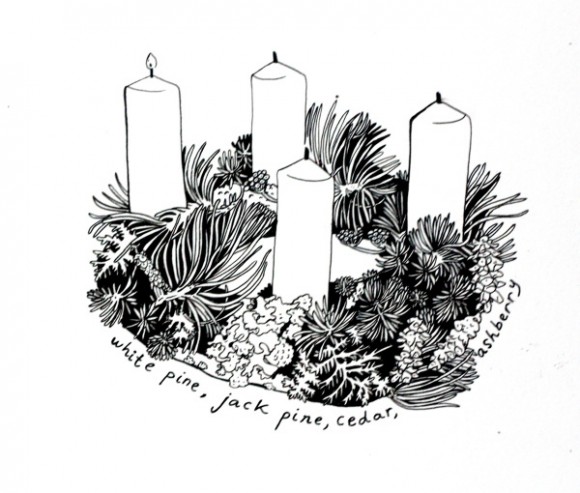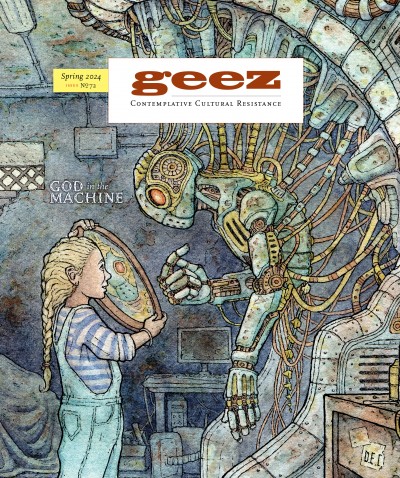Advent, Lighting the First Candle by Lydia Wylie-Kellermann

Sarah Holst
This piece was originally published in Geez 45: It’s Time! in 2014.
Ritual as Remembrance
The snow falls outside my living room window. I can hear my mom singing my little sister, Lucy, to sleep upstairs. I walk slowly to the door off the dining room that leads to our basement. I turn the knob slowly, trying not to make a sound. I go in and close the door tightly leaving me alone in the dark.
I walk down four steps and sit down. My feet are cold against the old wooden stairs. I tuck my arms into my pajamas, an oversized T-shirt covered with my sister’s brightly painted hand prints. I lean back against the wall. It smells damp and yet there is also the familiar, sweet scent of sawdust. It is coming from the same place as the lone light that escapes through the cracks of the door at the bottom of the stairs. I can hear music playing and the table saw running.
I sit for a long time. This is Advent. I listen trying to imagine what is being built that will soon sit under the Christmas tree. There is joy in the anticipation. Joy in the stillness and solitude. Joy in the waiting. Joy in the damp darkness of the basement steps.
Scattered throughout the house, we all have our little workshops. Tucked behind the pulled-out dresser is a workshop just my size, scattered with materials. Out of little bits of wax I make a manger scene on an old candle for my mom; I paint a picture of a forest for my dad; and for Lucy I am making a yarn doll like my mom taught me.
It was the same each year, never store-bought gifts. We tenderly crafted gifts for one another throughout Advent. To me, the liturgical season smells of wood and glue.
Each night before dinner, we would light the Advent wreath and sing for Emmanuel. As we grew older, we went from blowing out the candles to lighting them to gathering the pine to weave the wreath.
This past year, my three-year-old and I wove our wreath just like my mom did. The smells reminded me of her. I miss her touch and presence, yet in the act of picking the pine and lighting the candles, I feel her with us. As we sing “O Come, O Come Emmanuel” each night around the wreath, I listen to my 10-month-old hum along and I can hear my mom’s voice.
In our own corners, there are knitting needles, paper mache, fabric and scissors – soon to be scarves, musical instruments, and ornaments. In the remembering and embodiment of these rituals, I introduce my children to my mother.
So, this year and every year, we light the candles. We sing for Emmanuel. We pay attention to the light. We honour the dark. We watch the snow fall. We slow down. We create gifts. We give thanks for the cloud of witnesses. We join the great history of all those who have shared these traditions and will ever share them. We love those who have died and feel their love within the reenacting. We remember. We wait. We listen. We rejoice.
Reflections from a Liturgical Seasons Geek
The rain. The dew. The dryness. And then rain again, and dew, and dryness. The story of the circling year. From the rabbis, mystics, and farmers of sixteen centuries ago we have a book that tells the story of the circling year. That teaches us what to do if the delicate machinery should stop. – Rabbi Arthur Waskow, Seasons of Our Joy: A Celebration of Modern Jewish Renewal
I can’t deny it. It’s true. I crave the church seasons. I count down the days to Advent. I throw All Saints Day parties. I keep folders of poetry and reflections for each season. Honestly, I’m really not all that high-churchy, but the seasons have become a rhythm that I feel in my body. They ground me when the world feels crazy. They keep me moving. They slow me down. They keep me acting in the midst of hopelessness. They are a way of keeping time that feels dramatically different from the fast-paced, consumer-driven clocks that surround us.
Thinking about the year, I am struck by the carved out spaces for celebrating birth, honouring death, finding hope, remembering the dead, preparing our hearts, grieving, asking forgiveness, singing, celebrating, paying attention to the ordinary times, remembering and re-telling the old stories, and following the life of a radical man living under siege of empire. Not a bad way to spend a year and then to do it all over again.
I love how physical the liturgical seasons are. I mean it quite literally that I feel the rhythm in my body because each season awakens all of my senses with sounds, colours, songs, smells, and food. Some days call for great fire or single flames, for water poured as blessing, and even as ash and dirt rubbed on our foreheads. I can feel the dripping wax landing on my finger at the Easter Vigil or the smell of pine wrapped into a wreath during Advent.
That rhythm we tangibly experience becomes instinct as we do it again and again. Sister Joan Chittister, a Benedictine nun, writes in The Liturgical Year: The Spiraling Adventure of the Spiritual Life, “It is what we do routinely, not what we do rarely, that delineates the character of a person.” This begs the question, what it is that we do over and over? What are the practices we live by that start becoming who we are?
For my family, part of that repetition was resistance. Works of justice were tangled together with the liturgical seasons. We spent Mondays in Advent at a cruise missile plant – sometimes blockades and other times just a small vigil with candles. On Good Friday, we walked the streets of Detroit reflecting on the places where crucifixion was happening in that time and place. Justice became routine – as routine as lighting candles or reading the lectionary. Then too, the scriptures made more sense to me as a child. The liturgical season reminded me where to act, and the action awakened the meaning of the ancient season.
As my body walks those streets of Detroit in the spring or hangs the Christmas ornaments in December, I am struck by how much I feel connected to my mom. It is the repetition. The doing over and over again what I did so many times with her. When I sing the hymns, I hear her voice. When I bake Christmas cookies, I see her hands. When I teach my own children and see their delight, I see my grandmother and my grandchildren. Somehow these seasons connect us with the generations who came before and those who will come after. There is a sense in which as we break and eat that bread, we are joined in communion with all those who have ever broken bread and all those who ever will.
I give thanks for all of it – for living by a clock that needs no corporation, president, TV and, in fact, needs no church institution either. It models the kind of time we long and work for. Truth be told, both my parents were bigger geeks than me. My dad, Bill Wylie Kellermann, even wrote a book about the liturgical year. He wrote in Seasons of Faith and Conscience, “The church year, in both its contemplative aspect and its public enactment, may become a counter-culture rhythm, the different drummer, the recaller, the invoker of a world not yet seen, a subversive agenda for our collective hearts.”
I claim that subversive agenda and trust that doing it over and over again will seep into who I am summoned to be.


Start the Discussion